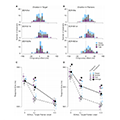Abstract
As documented by Darwin 150 years ago, emotion expressed in human faces readily draws our attention and promotes sympathetic emotional reactions. How do such reactions to the expression of emotion affect our goal-directed actions? Despite the substantial advance made in the neural mechanisms of both cognitive control and emotional processing, it is not yet known well how these two systems interact. Here, we studied how emotion expressed in human faces influences cognitive control of conflict processing, spatial selective attention and inhibitory control in particular, using the Eriksen flanker paradigm. In this task, participants viewed displays of a central target face flanked by peripheral faces and were asked to judge the gender of the target face; task-irrelevant emotion expressions were embedded in the target face, the flanking faces, or both. We also monitored how emotion expression affects gender judgment performance while varying the relative timing between the target and flanker faces. As previously reported, we found robust gender congruency effects, namely slower responses to the target faces whose gender was incongruent with that of the flanker faces, when the flankers preceded the target by 0.1 s. When the flankers further advanced the target by 0.3 s, however, the congruency effect vanished in most of the viewing conditions, except for when emotion was expressed only in the flanking faces or when congruent emotion was expressed in the target and flanking faces. These results suggest that emotional saliency can prolong a substantial degree of conflict by diverting bottom-up attention away from the target, and that inhibitory control on task-irrelevant information from flanking stimuli is deterred by the emotional congruency between target and flanking stimuli.
